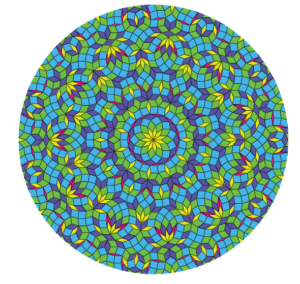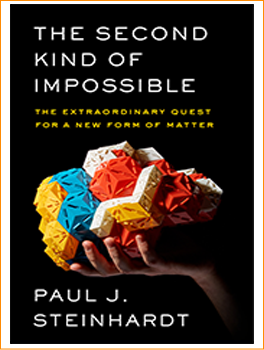The Second Kind of Impossible is the exciting, first-hand story of how Paul Steinhardt, the award-winning physicist and Albert Einstein Professor in Science at Princeton University, predicted a new type of matter – the quasicrystal – shattering centuries-old laws of physics. Steinhardt’s quest to prove the natural existence of quasicrystals takes him on a globe-hopping scientific journey from Princeton to Italy to the remote mountains of Russia’s Kamchatka Peninsula. In a “suspenseful true-life thriller of science investigation and discovery” (Publishers Weekly), readers are taken along for the ride as Steinhardt challenges commonly held assumptions about settled science, refuting skeptics and disproving their notions of impossibility along the way.

Steinhardt’s search to prove the existence of this rare crystal structure began in the early 1980s, when he first proposed the existence of “quasicrystals.” While studying abstract tile patterns, Steinhardt and his graduate student discovered a scientific loophole in one of the most well-established laws of science and, exploiting that, realized it was possible to create new forms of matter.
So what is a quasicrystal? Like a crystal, it’s made up of building blocks comprised of a cluster of atoms, but unlike a crystal, there can be more than one type of building block and the building block pattern of a quasicrystal never repeats identically. Each point is unique, yet there’s clear order—which allows for a range of mind-bending patterns. In the lab, quasicrystals could allow for materials as harder than steel and as slippery as Teflon. Yet perhaps most importantly for Steinhardt, the substance was never thought to exist by many of his colleagues and other scientific luminaries. A famous two-time Nobel Laureate once told Steinhardt, “There is no such thing as quasicrystals, only quasi-scientists.” Despite the skepticism of the Steinhardt’s colleagues and much of the scientific community, Steinhardt’s theory was proved possible when a scientific group working in a lab only 150 miles away managed to accidentally synthesize a quasicrystal in their lab. Steinhardt’s team had invented a theory of quasicrystals, but had no experimental proof. The other team had an experiment, but no theoretical explanation. Together, it was a radical, and yet fundamental, discovery about nature.
Once it was proven that a quasicrystal could be synthesized in a lab, it wasn’t long before Steinhardt had his next “impossible” idea: Might it be possible for perfect quasicrystals to develop on their own in the natural world, without any human intervention? It was this question that led Steinhardt and his team of geologists on a detective story across the globe, with a dizzying array of improbable twists and turns along the way. From examining crystals and specimens at museums across the country to panning for natural quasicrystals in Kamchatka, Russia—from encounters with corrupt scientists, fraudulent traders, and Russian security agents—Steinhardt’s journey is a scientific thriller of the first order.
In 2011, after Steinhardt’s Kamchatka mission was complete, Steinhardt was anxiously awaiting the results of the specimens his team had collected when Italian geologist Luca Bindi emailed him with the good news. One of the miniscule shards that they had extracted proved to be a meteorite fragment containing grains with the five-fold symmetry they were looking for. A quasicrystal. Steinhardt’s team had proven beyond a reasonable doubt that nature made quasicrystals long before humans fabricated them in the laboratory.
The lesson here, Steinhardt says, is to “Pay attention whenever someone says something is impossible and take the time to reach your own independent judgment.” With The Second Kind of Impossible, Steinhardt questions the very nature of science, and shows how the pursuit of his curiosities led to a marvelous new discovery that has forever changed our understanding of the universe.
NEW DISCOVERY! Accidental creation of a previously unknown quasicrystal in the first atomic bomb test on July 16, 1945 (the Trinity Test) in Alamogordo, New Mexico
THE SECOND KIND OF IMPOSSIBLE
The Extraordinary Quest for a New Form of Matter
By Paul J. Steinhardt
Published by Simon & Schuster on January 8, 2019
Hardcover ISBN: 9781476729923
Ebook ISBN: 9781476729947
